REVIEWER'S NOTE:This is my preliminary comparison of the new Dereelight DBS V2 compared to the original edition. The EDGETAC RaidFire Spear is also included for comparison purposes in the runtimes and output.
For a detailed comparison to all the other thrower lights in my collection, please see:
Thrower review: DBS, Spear, MRV, Tiablo, Regal & clones: THROW, RUNTIMES, BEAMSHOTS!
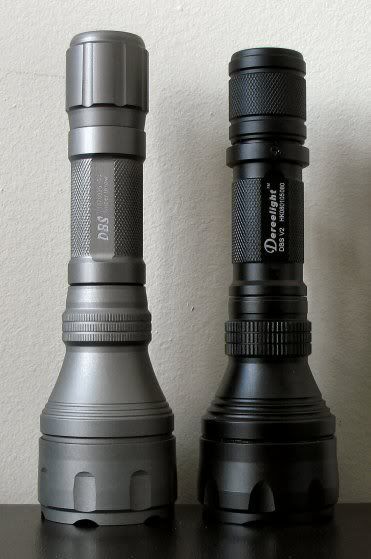

As you can see, the new V2 is shorter than the original, with a slightly different design to the bezel and tailcap. Also features a removable wire clip.
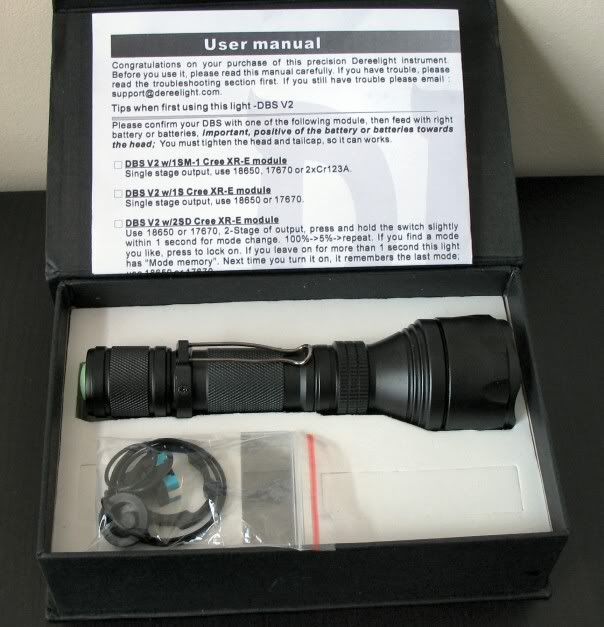
Light comes in the standard Dereelight presentation box with with cut-out padding, basic instruction manual, spare parts (o-rings, tailcap cover, switch replacement, clip bezel & screws).
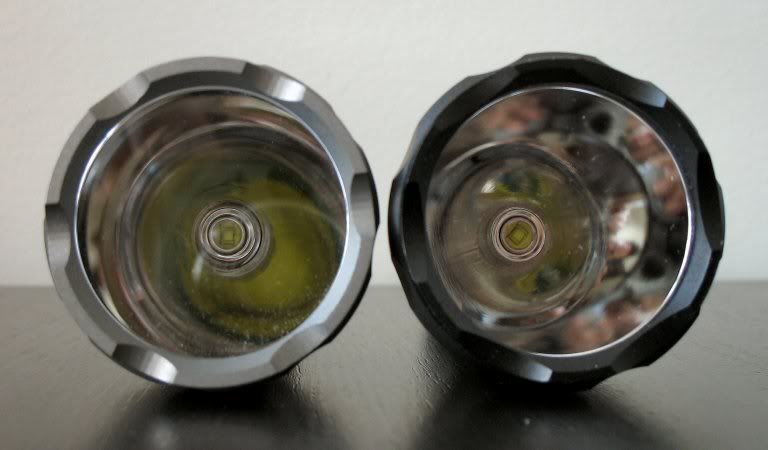
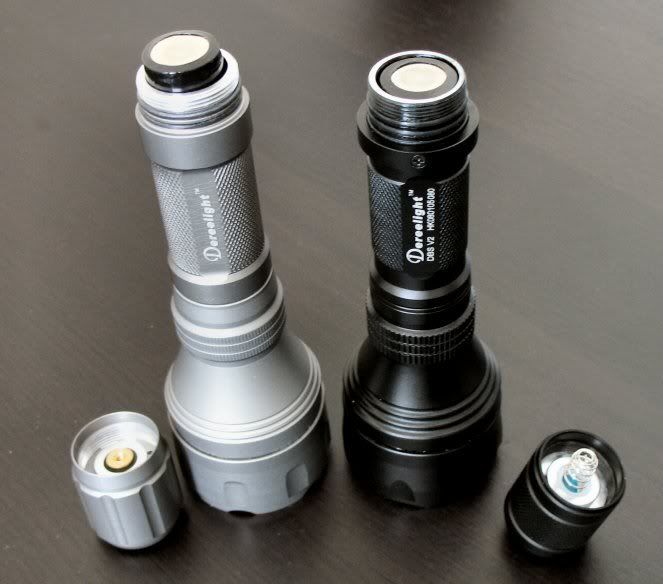
As you can see, unlike the original DBS, the tailcap screw threads are now anodized on both the battery tube and tailcap of the V2. This allows you to lock-out the light – a nice feature. :thumbsup:
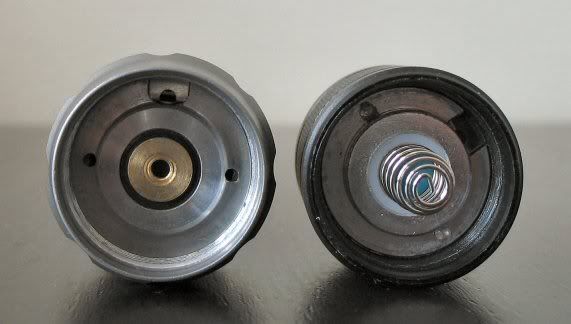
Switch now comes with a spring for battery contact. This wasn't needed previously as the extra contact spring in the original body tube helped press the battery against the contact plate in the tailcap. Although not shown in the pics, the threads between top of the battery tube and the head are also anodized.
A comment about the tailcaps: although not shown, the new V2 has a raised tailcap switch compared to the original. This makes it easier to activate the forward clicky.
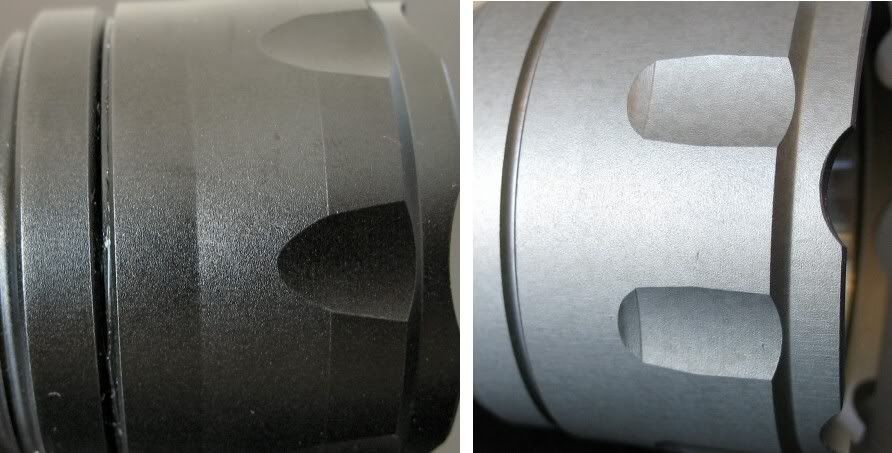
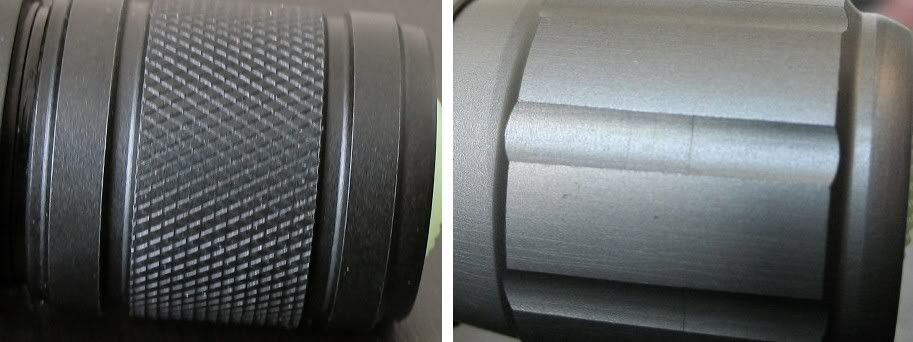
The quality of the machining and anodizing has definitely improved from the original DBS. Although I'm a fan of the darker black finish anyway, you can see for yourself that the earlier machining marks and "splotchiness" of the original anodizing are no longer present on the new V2. The lettering is also considerably sharper looking. :thumbsup:
Weight (without battery):
Dereelight DBS V2: 194g
RaidFire Spear: 191g
Dereelight DBS: 221g
Lumapower MRV: 195g
Tiablo A8: 151g
As you can see, the weight of the DBS V2 has dropped to within the range of the other throwers. Still a bit "top-heavy" compared to the Tiablo or Raidfire, it is improved over the original DBS.
I haven't taken disassembled pics, but the reason for the lower weight and height comes from the removal of the extra contact surface/spring at the top part of the battery tube (i.e. the positive terminal of the battery now makes direct contact with the pill spring). I've always maintained that the extra contact surface in the original DBS was just another potential source of problems – glad to see they have removed it.
The rest of this review will focus on the new continuously variable switch ("DI") with the new R2 bin Cree emitter.
Initial Throw Observations:
Throw values are the square-root of Lux measurements taken at 1m using a light meter. Note that my lightmeter tends to report lower absolute values than most, but I have verified it is linearly responsive over the range of intensities in question.
Dereelight DBS DI – R2 (18650-only) Throw Lux @ one meter:
* Note that the DI circuit quickly drops ~10% from the initial output/throw levels reported above within the first 2 minutes, then settles into regulation. See my runtimes below for more info.
Overall Output:
It is very difficult to accurately guage differences in overall output among these lights, since so much of their output is dedicated to "throw". I've attempted two methods: a ceiling-bounce test and my home-made milk carton lightbox. For the ceiling-bounce test, the light meter is placed on the floor of a small windowless room, and the flashlight is placed in candle mode nearby, shining upwards toward the ceilling. For the lightbox method, I use the same standard setup as I do for runtimes (see below for a description).
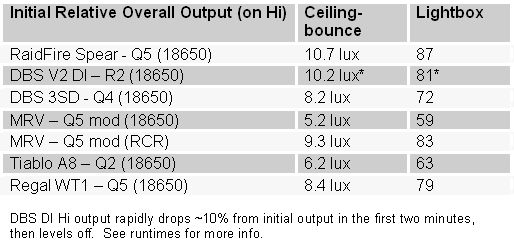
As you can see, initial output of the DBS V2 with the R2 Cree/DI circuit is intermediate to my old Q4 3SD and the RaidFire Spear. But again, initial output quickly decays to approximately Q4 3SD level (see runtimes below).
Runtimes:
Runtimes charts are slightly different from my other reviews - since my home-made milk carton lightbox doesn't accurately capture overall output on these intense throwers, I have adjusted all my relative output numbers to initial throw (measured as the squareroot of Lux @1m). This allows you to directly compare the relative throw of each light over time on the graphs below (although you can't directly compare these graphs with my other reviews).
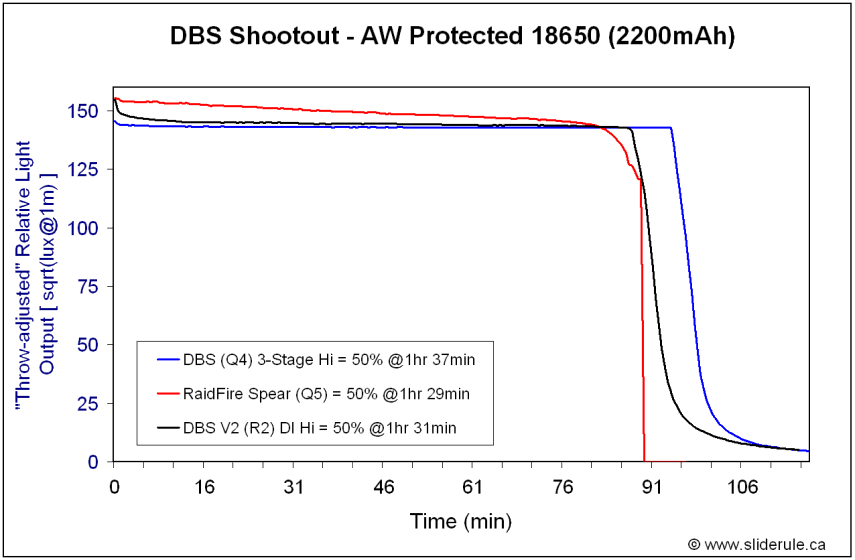
As you can see, initial output drops rapidly within the first 2 minutes, and then settles into regulation around the level of my Q4 3SD circuit. This will be a disappointment for those that expected greater output due to the higher output bin (R2), and the expectation that the DI circuit would be harder-driven than the old 1.0A 3SD.
Beamshots:
Up close beamshots at ~1 meter from a white wall, to show you the different overall patterns.
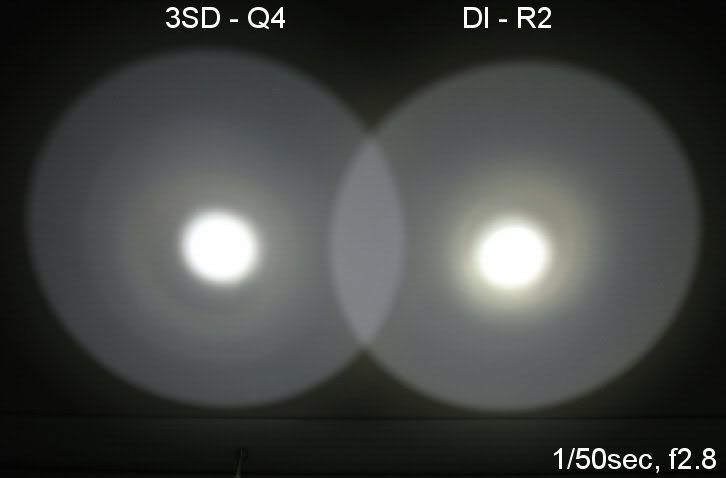
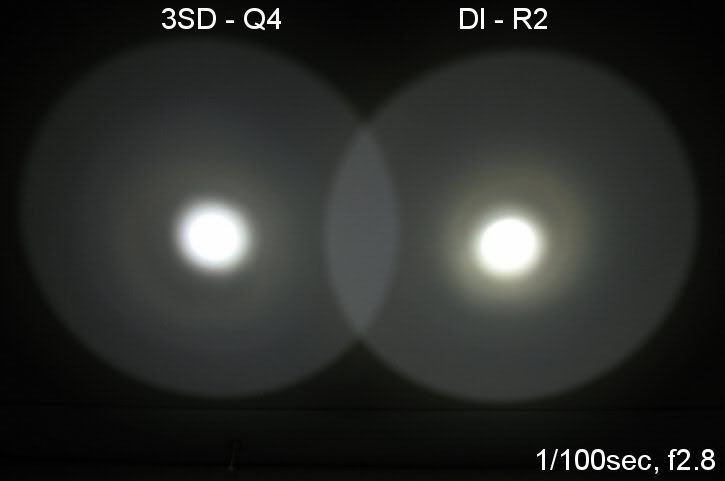
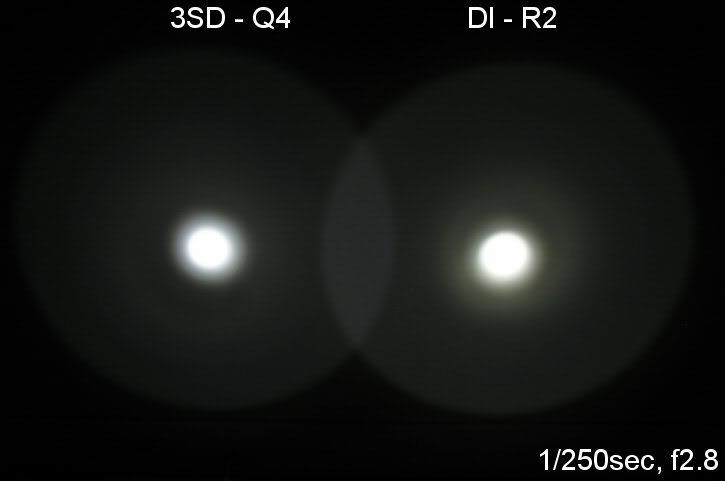
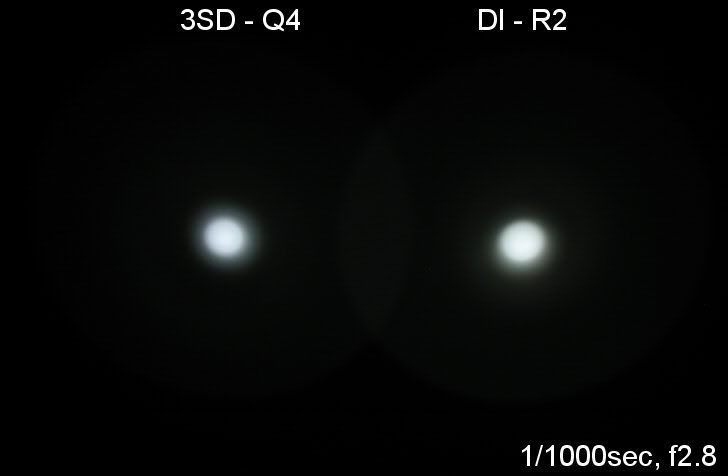
My camera is set to automatic white balance, and the real difference between the lights is not shown in the pics above. In real life, this WH tint bin R2 is quite yellow-green compared to the premium WC Q4 on the left. I would say my WH R2 sample looks very similar to ernsanada's samples.
DI Circuit User Interface
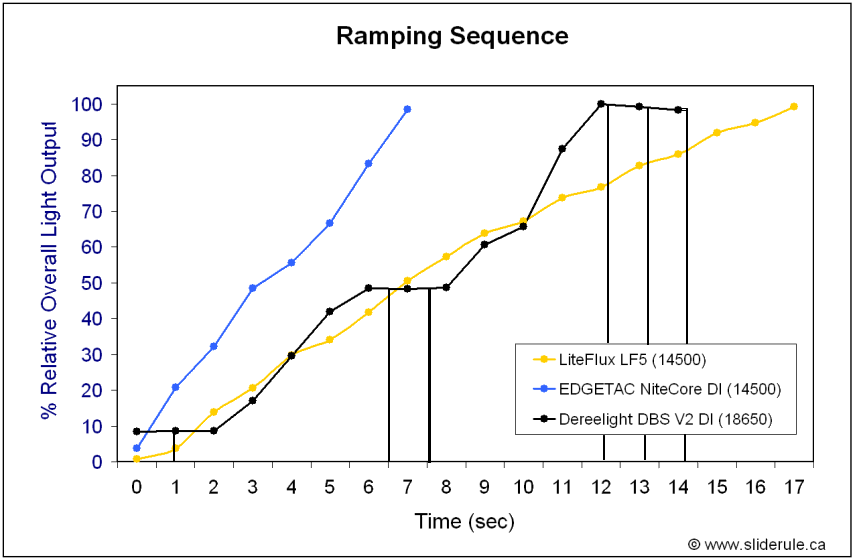
In the figure above, I compare the ramping sequence to that of the LiteFlux LF5 and EDGETAC NiteCore DI. Note that I have reformulated my ramping graphs in terms of % relative output (i.e. % of max output) to allow you to more easily compare the rates and characteristics of the ramps.
As you can see, the ramp is fairly quick and roughly visually linear, except for the 2 sec pauses at 5%, 50%, and 100% output levels (vertical lines at these points are to illustrate the flashing that occurs).
Preliminary conclusions: (I've only started playing with the light, so these will be updated ...)
More to come ...
For a detailed comparison to all the other thrower lights in my collection, please see:
Thrower review: DBS, Spear, MRV, Tiablo, Regal & clones: THROW, RUNTIMES, BEAMSHOTS!


As you can see, the new V2 is shorter than the original, with a slightly different design to the bezel and tailcap. Also features a removable wire clip.

Light comes in the standard Dereelight presentation box with with cut-out padding, basic instruction manual, spare parts (o-rings, tailcap cover, switch replacement, clip bezel & screws).


As you can see, unlike the original DBS, the tailcap screw threads are now anodized on both the battery tube and tailcap of the V2. This allows you to lock-out the light – a nice feature. :thumbsup:

Switch now comes with a spring for battery contact. This wasn't needed previously as the extra contact spring in the original body tube helped press the battery against the contact plate in the tailcap. Although not shown in the pics, the threads between top of the battery tube and the head are also anodized.
A comment about the tailcaps: although not shown, the new V2 has a raised tailcap switch compared to the original. This makes it easier to activate the forward clicky.


The quality of the machining and anodizing has definitely improved from the original DBS. Although I'm a fan of the darker black finish anyway, you can see for yourself that the earlier machining marks and "splotchiness" of the original anodizing are no longer present on the new V2. The lettering is also considerably sharper looking. :thumbsup:
Weight (without battery):
Dereelight DBS V2: 194g
RaidFire Spear: 191g
Dereelight DBS: 221g
Lumapower MRV: 195g
Tiablo A8: 151g
As you can see, the weight of the DBS V2 has dropped to within the range of the other throwers. Still a bit "top-heavy" compared to the Tiablo or Raidfire, it is improved over the original DBS.
I haven't taken disassembled pics, but the reason for the lower weight and height comes from the removal of the extra contact surface/spring at the top part of the battery tube (i.e. the positive terminal of the battery now makes direct contact with the pill spring). I've always maintained that the extra contact surface in the original DBS was just another potential source of problems – glad to see they have removed it.
The rest of this review will focus on the new continuously variable switch ("DI") with the new R2 bin Cree emitter.
Initial Throw Observations:
Throw values are the square-root of Lux measurements taken at 1m using a light meter. Note that my lightmeter tends to report lower absolute values than most, but I have verified it is linearly responsive over the range of intensities in question.
Dereelight DBS DI – R2 (18650-only) Throw Lux @ one meter:
- 18650 x 1 on high (100%): 23,900 Lux (* but not for long, see below)
- 18650 x 1 on med (50%): 13,100 Lux
- 18650 x 1 on low (5%): 980 Lux
- 18650 x 1 on high: 21,200 Lux
- 18650 x 1 on medium: 10,500 Lux
- 18650 x 1 on low: 1,830 Lux
- 18650 x 1 on high: 24,000 Lux
- 18650 x 1 on low: 360 Lux
* Note that the DI circuit quickly drops ~10% from the initial output/throw levels reported above within the first 2 minutes, then settles into regulation. See my runtimes below for more info.
Overall Output:
It is very difficult to accurately guage differences in overall output among these lights, since so much of their output is dedicated to "throw". I've attempted two methods: a ceiling-bounce test and my home-made milk carton lightbox. For the ceiling-bounce test, the light meter is placed on the floor of a small windowless room, and the flashlight is placed in candle mode nearby, shining upwards toward the ceilling. For the lightbox method, I use the same standard setup as I do for runtimes (see below for a description).

As you can see, initial output of the DBS V2 with the R2 Cree/DI circuit is intermediate to my old Q4 3SD and the RaidFire Spear. But again, initial output quickly decays to approximately Q4 3SD level (see runtimes below).
Runtimes:
Runtimes charts are slightly different from my other reviews - since my home-made milk carton lightbox doesn't accurately capture overall output on these intense throwers, I have adjusted all my relative output numbers to initial throw (measured as the squareroot of Lux @1m). This allows you to directly compare the relative throw of each light over time on the graphs below (although you can't directly compare these graphs with my other reviews).

As you can see, initial output drops rapidly within the first 2 minutes, and then settles into regulation around the level of my Q4 3SD circuit. This will be a disappointment for those that expected greater output due to the higher output bin (R2), and the expectation that the DI circuit would be harder-driven than the old 1.0A 3SD.
Beamshots:
Up close beamshots at ~1 meter from a white wall, to show you the different overall patterns.




My camera is set to automatic white balance, and the real difference between the lights is not shown in the pics above. In real life, this WH tint bin R2 is quite yellow-green compared to the premium WC Q4 on the left. I would say my WH R2 sample looks very similar to ernsanada's samples.
DI Circuit User Interface
- The DI circuit is continuously variable with preset levels of 5%, 50%, and 100% output.
- Double-tap the switch within 1 sec to get it to start ramping. Light begins at the lowest level and ramps up.
- Light ramping pauses at 5%, 50%, and 100% levels for 2 secs each time, and flashes off to let you know you are there (i.e. 1 flash at 5%, 2 flashes at 50%, and 3 flashes at 100%).
- To set the light at any given level, simply turn it off when you reach the desired output.
- Light has a memory mode – it remembers the last level you left it at when you turn it back on.
- Light uses PWM for low modes. I have measured the freq at 121 Hz in all low modes, including during ramping.

In the figure above, I compare the ramping sequence to that of the LiteFlux LF5 and EDGETAC NiteCore DI. Note that I have reformulated my ramping graphs in terms of % relative output (i.e. % of max output) to allow you to more easily compare the rates and characteristics of the ramps.
As you can see, the ramp is fairly quick and roughly visually linear, except for the 2 sec pauses at 5%, 50%, and 100% output levels (vertical lines at these points are to illustrate the flashing that occurs).
Preliminary conclusions: (I've only started playing with the light, so these will be updated ...)
- So far, the V2 seems to be a considerable improvement on the original DBS in every way – machining, anodizing, length, weight, and ease of action of the switch. Well done! :thumbsup:
- Inclusion of the belt clip is a good idea, and seems to work well in my initial testing.
- The new R2 Cree (WH tint bin) coupled with the continuously variable (DI) circuit is a bit of a disappointment. Initial output is about what I expect from a Q5, and it quickly drops down to a Q4 level when it enters regulation after ~2 mins. :shakehead
- Current users of the various Q4 or Q5 digital circuit DBS' are likely to be disappointed by the output and tint of the R2 (although non-premium tint was advertised in advance). Light does seem to be a WH tint.
- The DI interface works well, but output and runtime suggest that it is NOT driven harder than the original 1.0A 3SD. Throw junkies might want to stick with the harder driven 2SD (2-stage digital) circuit (which is supposedly 1.2A).
- PWM frequency on the DI circuit is a minimally respectable 121 Hz. Personally, I find anything lower than this distracting in every day use. Note than my 3SD Q4 had an undetectably high level of PWM in comparison (i.e. >1 kHz)
- My DI R2 pill also produces a lot more "whine" or buzzing in low modes than my 3SD Q4 did, despite the much lower PWM.
More to come ...
Last edited:

